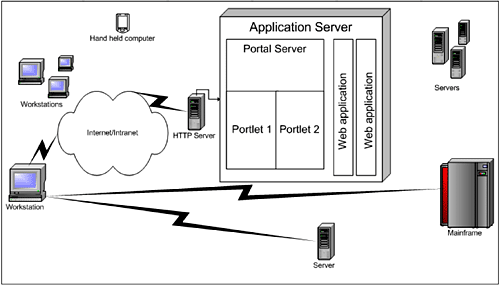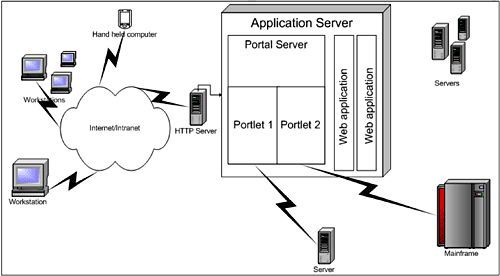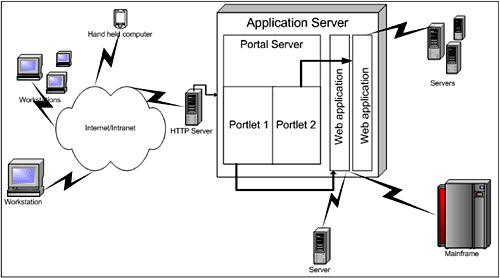1.5 Portlet solution patterns
| < Day Day Up > |
| Enterprise Resource Planning (ERP) and Customer Relationship Management (CRM) systems are excellent candidates for portlets because efficient, personalized access to these functions provide measurable returns on your portal investment. WebSphere Portal includes portlets that help you access a variety of ERP and CRM systems. Enterprise Applications running on a back-end or host system are another group of candidates for portlets, especially when the portal addresses the business-to-employee pattern and you want to provide a common working environment to your users, whatever application and system they may need for their work. There are many ways to perform application integration in a Web environment. Not all of them are based on portlets and amongst the portlet-based solutions, several different architectural approaches can be applied. Depending on technical circumstances, the given time frame and the goals of the integration, typically, different approaches may be combined in one portal solution. We try to list some of the patterns you might think of. One way we can differentiate is shrink-wrapped versus roll-your-own. Customizable portlets from a vendorIn this pattern, a portlet is provided which can be installed in Portlet Server and, after a configuration effort, the system or application in question can be accessed through the portal. Often, such a portlet is delivered by the vendor of the system that should be accessed. Both the Host On-Demand portlet and the Host Publisher portlet we use in the following examples are of this type. Custom developed portletsThis pattern comes into play when either no vendor offers a portlet for the requested application, or the requested level of functionality, usability, accessibility or security is not met by the existing portlets. Another reason might be that you want to combine information or functionality of multiple applications seamlessly into one portlet. Most probably, this integration will include using the Java Connector Architecture (JCA). JCA is a standard architecture for integrating J2EE applications with Enterprise Information Systems that are not relational databases. Each of these systems provides native APIs for identifying a function to call, specifying its input data, and processing its output data. The goal of the JCA is to achieve an independent API for coding these functions. JCA also defines a standard Service Provider Interface (SPI) for integrating the transaction, security and connection management facilities of an application server with those of a transactional resource manager. Thus, JCA is a standards-based approach to managing connections, transactions, and secure access to enterprise application systems. IBM's JCA connectors provide access to systems such as SAP, People Soft, CICS , and IMS ¢. Leveraging its CrossWorlds acquisition, IBM will also develop and integrate JCA connectors to many other systems. Another way to look at portlets for application integration is from a topology point of view. Client to remote applicationIn this pattern, for example used by IBM Host On-Demand, the portlet is just a bootstrap to allow the client to get in touch with the requested system or application, and Portal Server is the framework for the user interface. This implies that normally, an applet is involved which makes a direct network connection to a remote system. Figure 1-13. Portal Solutions-client to remote application Portlet to remote applicationThis is the topology most likely used if you write your own application integration portlet. Access to the requested application or information is gained through standardized interfaces such as JCA connectors, JDBC and JMS, or by using a proprietary API provided by the application that is to be integrated (for example SAP Business Connector). Figure 1-14. Portal Solutions-portlet to remote application Portlet to Web applicationIn this pattern, most of the work is done in a Web application. Also, if you write a Web application using the JCA or EJB and create a portlet interface to it, you follow this pattern. The enterprise application integration does not stop here at integrating with ERP and CRM systems. Figure 1-15. Portal Solutions-Portlet to Web application |
| < Day Day Up > |
EAN: 2147483647
Pages: 148


